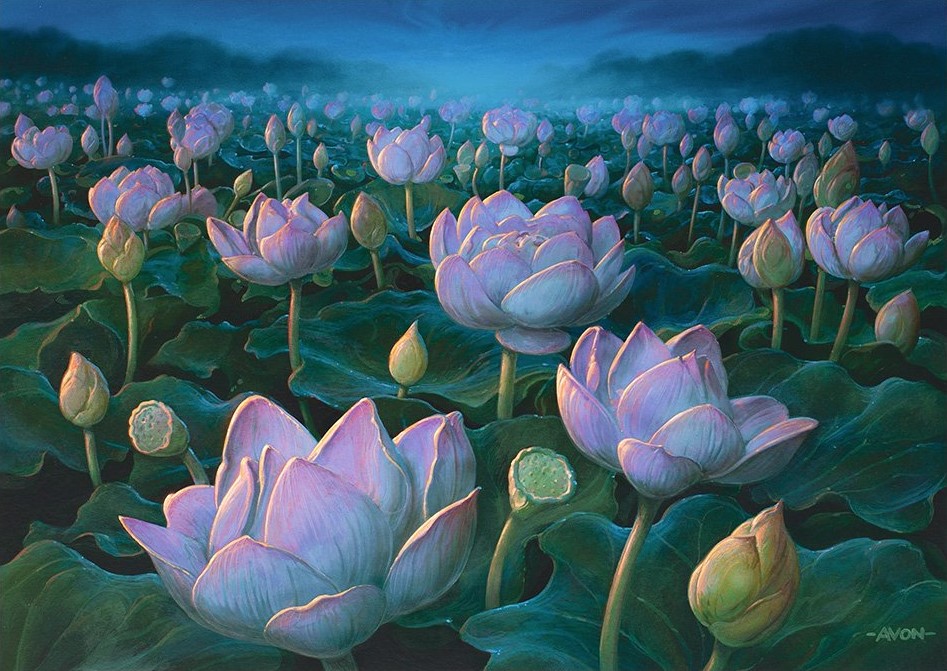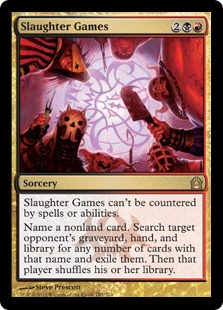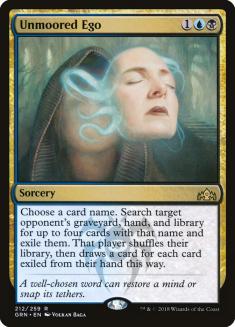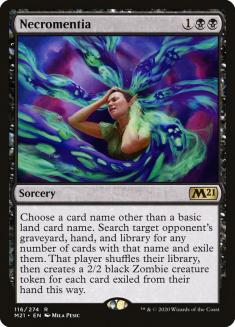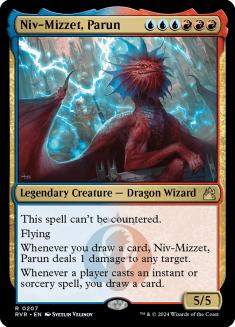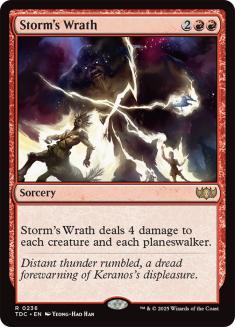Magic players have a strange relationship with memory.
Individually, you can often ask a competitive player about a match they played at a Grand Prix event in 2014, and they’ll be able to recreate it with precision. Frequently, they’ll be able to tell you how their opponent savagely topdecked on them when they needed one more turn to lock up the game. Occasionally, they’ll be able to pinpoint a decision that cost them the game or one they made right that got them the win. They’ll tell you about a Sealed pool from a PTQ in 2009 in an event hall in the middle of nowhere, when they got three on-color bomb rares and cruised to the Top 8. They can tell you the decklist they used to conquer their local IQ two years ago, beating SCG Tour ringers with their sweet piece of new sideboard technology.
But ask the collective, especially in the age of social media, to take a step back and try to think about what decks were good in a format immediately prior to a game-changing set (like Theros Beyond Death), and they’ll scratch their heads. “Was that Mono-Red? I forget. Didn’t we have Once Upon a Time and Oko, Thief of Crowns? Mono-Black with Smuggler’s Copter? Izzet Ensoul?”
Competitive Magic changes rapidly nowadays, but the very first place to look after this slew of bannings is the format immediately before the offending cards took over. In this case, it’s Pioneer before Lotus Breach and Dimir Inverter. Mono-White Devotion wasn’t playable (if we remember, it was the Walking Ballista + Heliod. Sun-Crowned combo that put it to Tier 1).
The best decks? Mono-Black Aggro, Mono-Black Vampires, Mono-Red Aggro, and Five-Color Niv-Mizzet. Azorius Spirits, Izzet Ensoul, Golgari Hardened Scales, Mono-Green Devotion, and Sultai Delirium existed as well, and one little combo deck made occasional appearances.
No, it wasn’t the Simic Nexus deck; that one had been banned. Something about Wilderness Reclamation and Nexus of Fate being the best cards in Pioneer after being ban-worthy in Standard pushed Wizards of the Coast (WotC) to hit that deck before it became truly obnoxious. However, before Underworld Breach hit the scene and turned Lotus Field into the best land in the format for a few months, there was a slightly worse version of the same combo deck quietly doing its thing.
Sometimes it pays to trawl older StarCityGames.com articles to try to find that deck you think existed, but don’t quite remember, but you have a feeling that it might be good again. Ari Lax did actually dive in and explore the older version of Lotus Field Combo.
After Underworld Breach got printed, things got a little out of hand, but now we’re turning back the clock on 2020 (wish that we could turn the clocks back on 2020 in more ways than just the printing of Underworld Breach!) This is where Lotus Field Combo was just prior to everything falling to pieces.
As we all know, the juiced-up version of Lotus Breach won a lot of matches until significant amounts of dedicated hate cards started popping up in decklists. Now a pared-down older version of the same deck still exists, but everyone seems to have forgotten about it. This makes it a sleeper pick for your next Pioneer tournament.
Creatures (14)
Lands (24)
Spells (22)

This deck beats the unprepared. It won’t beat prepared opponents, but then again, neither did the Underworld Breach version. It’s going to exert pressure on the metagame the same way Lotus Breach did. Slowly it starts creeping back up online, and then all at once it wins a bunch. The metagame will correct itself with appropriate hate cards, slacken, and become weak once again. It happened with the more powerful Underworld Breach version over the last seven months.
Fortunately, we have a chance to adjust despite a major downgrade in the raw power of this deck. There’s no deterministic kill anymore like the way Tome Scour and Hidden Strings did it, but we can add more pieces to increase consistency. Is Growth Spiral the answer? More Dig Through Time, for sure. Doublecast is a nice touch with powerful effects like Pore Over the Pages, turning seven mana into twelve and churning through a nice chunk of the deck. How much worse is this version, really? Especially when opponents relax their focus on your particular brand of shenanigans?
As it currently stands, Five-Color Niv-Mizzet is a good matchup, as long as they don’t start packing multiple maindeck Extraction effects such as Slaughter Games and/or Unmoored Ego. Because of the way this version of the deck is constructed, there’s no way to beat a Slaughter Games on Fae of Wishes if they hit it ahead of you casting a Granted. Likewise, there’s no way to beat a preemptive Unmoored Ego on Lotus Field. One solution is to include one or two copies of Ral, Storm Conduit or Expansion // Explosion in the maindeck, which can mimic the effect of Doublecast while offering an alternative way to win in the event all your copies of Fae of Wishes get exiled.
Mono-Black Aggro is not quite as strong a matchup, especially if they maintain some number of sideboard Necromentia to disrupt your ability to combo off. However, you play a decent number of good roadblocks in Arboreal Grazer and Satyr Wayfinder to buy time, and you combo off consistently on Turn 5, so there’s no reason why you can’t win this matchup.
It gets even better if they’re playing the slower Mono-Black Vampires variant. With fewer aggressive creatures and more planeswalkers and expensive bombs, that version is closer to a freeroll than the deck full of 2/1 creatures. It beats up on the more aggressive version with powerful swingy cards like Sorin, Imperious Bloodlord, but that card doesn’t do enough on its own to pressure Lotus Field Combo quickly. I’m cautiously optimistic about this deck’s chances with both Mono-Black and Five-Color Niv-Mizzet in the format.
However, it’s not clear that the deck can beat Azorius Spirits consistently. Grazer has reach, which is excellent to buy lots of time against small flying creatures, but multiple maindeck counterspells and more in the sideboard mean things are not going to be easy. The saving grace here is that you generate a lot of surplus mana with this deck, so cards like Mausoleum Wanderer and Lofty Denial are actually not as strong against you as they’d seem at first blush. Really, though, if a key Hidden Strings gets hit with a Spell Queller, you’re likely to lose that game.
The secret to beating Azorius Spirits? Niv-Mizzet, Parun. The two-color Niv-Mizzet, this one is practically unbeatable if you untap with it. They can’t counter it, they’ll bring in a mittful of dead Disdainful Strokes and Mystical Disputes, and they’ll immediately lose. It does require you to have your mana engine online (since you can’t cast the card without a Lotus Field on the battlefield), but if you ever resolve a Granted against them, it’s an excellent target.
Additionally, if you need to improve the matchup even more, Ratchet Bomb may end up being a worse sideboard card than a second or third Niv-Mizzet! The opponent will salivate at the thought of countering a Granted with a Mystical Dispute, especially if they’re savvy enough to realize that you’re probably getting an uncounterable win condition with it. But they can’t do anything about the Niv-Mizzet you draw naturally!
Sultai Delirium, similar to Bring to Light, is slow enough that you can almost always win Game 1, and although they bring in a bit of disruption from the sideboard, you’re still favored in the matchup. Again, because Mystical Dispute is the most common form of disruption and you’re practically immune to it once you get your Lotus Field and Thespian’s Stage out there, you’re likely to be very happy with the matchup overall. They could create some problems for you if they began playing larger numbers of discard and countermagic in the sideboard, which could buy them enough time to get an Emrakul on the stack and win from there, but as the popular lists are currently constructed, it seems unlikely that things would shake out that way.
Mono-Green Devotion is picking up again, which is completely understandable given that Oath of Nissa has been unbanned. Four of the best combo decks were simultaneously dismantled or weakened, and the best card for that deck’s consistency is now running free. The matchup between that deck and Lotus Field Combo is completely non-interactive and uninteresting, though it’s close when it comes to win percentages.
The player who wins the die roll is at a substantial advantage, with both players likely to win on Turn 5 given no resistance. Absolute top-level draws from either player could result in a win on Turn 4, but bear in mind that Lotus Field Combo could delay Mono-Green Devotion with a Granted for a Storm’s Wrath (or Hour of Devastation, should you choose to play that card in the slot instead). Mono-Green Devotion does apply reasonable pressure even with some of its lower-percentile draws, so overall it’s likely a wash. A card like Fog could be a useful measure in the sideboard to add percentage to the Lotus Field Combo side as well.
As for Mono-Red Aggro, it’s a straight race, one where Eidolon of the Great Revel makes things quite difficult for the Lotus Field Combo player. This is not a matchup I’m excited to play from the combo side, but perhaps a card like Uro, Titan of Nature’s Wrath could be worth considering as a pseudo-hate card. Mono-Red has been kept mostly suppressed by the presence of this insanely strong creature, so I’m not as concerned about this aggro deck pushing Lotus Field Combo out of the format.
This is a common enough theme in metagame evolution, and it’s good to see that the dynamism of Pioneer is back with the banning of a bunch of key combo pieces. Now we have some aggro and aggro-control decks, which are likely to be defeated by midrange piles like Sultai Delirium and Five-Color Niv-Mizzet, which themselves are weak to various combo decks depending on which hate cards they play in a given week. Unfortunately, with a toolbox deck featuring cards like Bring to Light, it is possible that there will exist an end state of the metagame with a well-balanced deck that covers every playable combo deck and still fights aggro, but for the next few months we can enjoy the settling down of Pioneer.
During that time, it will be easy to exploit holes in the metagame, whether with a deck like this one, a well-tuned or more advanced midrange toolbox deck, or a well-timed Mono-Green Devotion deck with the right sideboard. But make no mistake. This metagame, too, will eventually converge on an end state and the masses on social media will clamor for corrective bans. Just remember how open and fun the format is now when adding your voice to the push to ban Uro.

